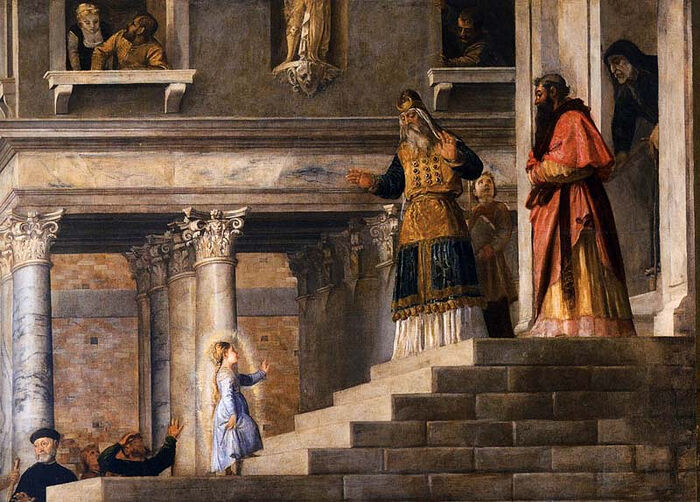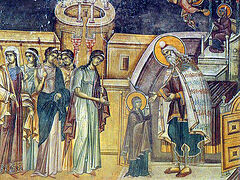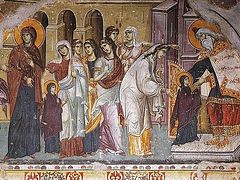The feast of the Entrance is very interesting. On the one hand, it something we seemingly understand and are accustomed to. But on the other hand, we do not always recognize the depth of meaning that the Church has given it.
 The Entrance into the Temple of the Most Holy Theotokos
The Entrance into the Temple of the Most Holy Theotokos
Children feel that the Entrance is their own feast day
We know that in recent times, the feast of the Entrance into the Temple of the Most Holy Theotokos has been seen as a feast of all Christian children. The God-Chosen Virgin herself was brought into the temple as a three-year-old child, and so all children should feel that this is their own feast day. This is appropriate. But it is not entirely bound up with the Theotokos’s childhood alone, because the mystical content of this feast day, or the vector that leads us to the next event, is the Nativity of Christ. And it is no coincidence that it is always celebrated at the beginning of the Nativity fast.
Why did the high priest Zachariah break the Law?
Ancient people, or rather, the people of the Bible, had a special kind of intuition, a spiritual inspiration, that we would now call charisma. After all, modern man is in a certain sense programmed; he acts according to the external norms of etiquette. But the heart of ancient man was always open to revelation, hidden from contemplative perception.
Let us recall the moment when Balaam went to curse the Israelite people, but suddenly the donkey stopped and spoke with a human voice. Instead of a curse he came and pronounced a blessing. Only saints and people of profound spiritual praxis are able to see manifestations such as this. High Priest Zacharias, who met the Most Holy Theotokos, was just such a man. He saw with his spiritual eyes in this little girl the Great Maiden, who will give birth to the Messiah of the Israelite people—the Savior. And the high priest, by the inspiration of the Holy Spirit, committed an act that according to the Law amazed, perhaps even scandalized many. But we know that all events that happen according to God’s inspiration do not have an ordinary, systematic meaning. They are out of the box, but they are justified because that is how God wishes it to be.
The Child-Virgin comes into direct contact with God…
Through the Entrance into the Temple, the Virgin as a child showed all the pagan peoples that there is salvation, that it is prepared not only for Israel. God wants to restore His covenant with man, and call him to this. And this threshold, this point of return to the covenant with God was the Most Holy Theotokos.
According to Old Testament understanding, women were in general considered weak, infirm, and not quite perfect beings. And here God shows that through Her, through this little girl, the Savior will come into the world; that She is the embodiment of all mankind, which will be saved. Moreover, the three-year-old Virgin is the main personage acting in all these events.
The Entrance of the Theotokos into the Holy of Holies is the beginning of man’s salvation, and the Child Mary is its direct participant. The first person to recognize this was High Priest Zacharias. At the inspiration of the Holy Spirit he took in the hidden mystery and showed it to those standing in the temple, while to the Mother of the whole world was revealed the reception of divine grace.
And thus, the Theotokos herself enters into the Holy of Holies—where God-Shekhina is present. In translation from the Hebrew, this term means “the presence of the Most High”. God is everywhere, all around, but there is a place of His particular presence. The Theotokos comes into direct contact with God, Who will act directly through her in the future: The Father will bless, the Holy Spirit will sanctify, and the Son of God will come down and be born. Three persons of the Holy Trinity come together in the Holy of Holies, the history of mankind is changed, and God’s promise is fulfilled; here God’s Chosen One is manifested to the world—she who will become the cause of mankind’s salvation. Through her will come Christ. And the high priest is only the accompanier, the conduit, who gives others the opportunity to see what is already taking place.
In entering the Holy of Holies, the Theotokos as if brings all people in after her
The event itself of the Entrance into the Temple of the Child-Virgin shows that she is consecrated to God; she is the pre-chosen vessel that will become the bearer of the Son of God. And in entering there, the Theotokos as if brings all people in after her; she shows that through her all mankind can be saved and enter into Paradise, that it will return to that sacred, ancient sphere that it lost through the original sin of its first parents.
At the services for the Feast of the Entrance, we also partake of the grace of Divine revelation
The divine services reveal to us the mystery of God’s Economy, which has not only begun to come into reality—it is already prepared and needs to be received. We could say that through the present, the past and the future are met. This meeting as if shows what God has conceived—the mystery of salvation. Therefore, the Entrance is a mystical feast, which must be perceived as an event that very directly related to us. For those people standing at the divine services on the Feast of the Entrance, God gives a living revelation; that is, we partake of this grace. By this God again gives us hope, firm assurance and conviction of the fact that salvation and Economy continues, it moves forward, and the promises He gave us in the Scriptures are not empty noise. They are coming to pass.
The Entrance into the Temple of the Most Holy Theotokos gives us the opportunity to vividly feel the close presence of the Messiah. As it is written in the Scriptures, He is not yet visible, He is somewhere there, beyond the hills; but His presence is already near, and His rays already shine…




